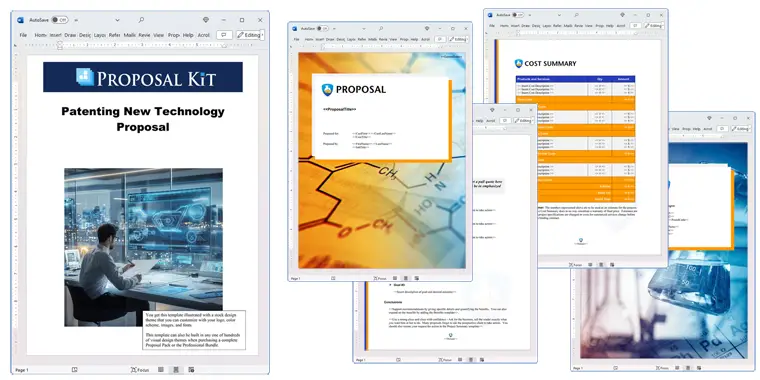How to write your Patenting New Technology Proposal
We include this 17 page layout with every Proposal Pack. If you want this template to have a different visual design theme than the one illustrated here, purchase any Proposal Pack design and create this template using the purchased design theme. This template is included in every Proposal Pack. If you get a Proposal Pack or the Professional, you can also make any variation of this template with different chapters to suit your needs.
We typically include more chapters in the templates than most people will need to give everyone more variety in the chapters they may need. You can trim down a long template by removing pages you do not need or combining multiple chapter topics into one page.
 DOWNLOADABLE, ONE-TIME COST, NO SUBSCRIPTION FEES
DOWNLOADABLE, ONE-TIME COST, NO SUBSCRIPTION FEES![]() View Patenting New Technology Sample Proposal
View Patenting New Technology Sample Proposal
This sample proposal is based on the same layout as this template and is included in every Proposal Pack. The visual design of the templates will match whichever Proposal Pack design you purchase. To get this template in a different design theme than shown in the sample, purchase any other Proposal Pack design theme and this template will be included.
You can create an editable Word version of this sample in any design theme of your choice including branded to your logo.
You can also create countless variations of this document to suit your needs using the included library of 2200+ chapters if ordering a Proposal Pack or Professional.
 What Our Clients Say
What Our Clients SayProposal Pack energy edition has made life very easy for me in terms of last minute proposal submission to various projects I have bidded in Africa. My company Solaris works with African govts to bring solar to the people . Just returned from one of such trips very proud of this program. Have recommended to many I came in contact with. Can’t get any better than this. User 4+ years."
Solaris Energy
Related Article
Related Video
Related Templates
- Patent and Invention Licensing Proposal
- Patent Proposal
- Patenting New Technology Proposal
- Selling a Company and Assets Counter Offer Proposal
- In-House Lab to Save Costs and Protect Trade Secrets Proposal
- Intellectual Property Rights Licensing Proposal
- AI Predictive Maintenance Algorithm Patent Proposal Template
- Due Diligence Project Proposal
What's the best way to write your patenting new technology proposal?
A proven solution to write a patenting new technology proposal is to use the Proposal Kit template and software package. This system provides a robust template library and integrates a comprehensive line item quoting database for cost summaries, quotes, estimates, budgets, and other financial details crucial to your proposal.
Are you tasked with writing a proposal for a new technological invention or innovation within your company? If so, the Proposal Kit could be an important tool for you.
What Types of Projects Are Patenting New Technology Proposals Written For?
Patenting new technology proposals are important documents tailored for various innovative projects. These proposals facilitate obtaining patents for new technologies and are crucial in diverse sectors. Here are examples of where such proposals are written:
- Developing a new software application
- Inventing a new medical device
- Creating a new engineering tool
- Launching a new agricultural machinery
- Developing new sustainable energy solutions
- Innovating new automotive technologies
- Creating new aerospace technologies
- Developing new robotics capabilities
- Innovating wearable tech devices
- Creating new telecommunications tools
- Developing new consumer electronics
- Innovating new gaming technologies
- Creating new biotechnologies
- Developing new chemical processes
- Innovating new materials or alloys
- Creating new optical devices
- Developing new surveillance technology
- Innovating new educational tools
- Creating new Internet of Things (IoT) devices
- Developing new artificial intelligence applications
Chapters this template is built with
No one-size-fits-all template works for every situation when creating a patenting new technology proposal. However, Proposal Kit software allows users to generate customized templates from an extensive library of over a thousand chapters. Below are some chapters that you might consider including in your proposal:
Cover Letter
The Cover Letter is your first impression. It introduces your proposal and makes a preliminary case for your new technology. Use this section to briefly explain the purpose of the proposal, the innovation you are presenting, and why it is relevant to the recipient. A compelling cover letter sets the stage for the following details and should encourage the reader to continue through the document.
Executive Summary
The Executive Summary is a condensed version of the entire proposal. It should summarize the key points, including the problem your technology addresses, the proposed solution, and the potential impact. This section is crucial for busy executives who might not have time to read the full document but need to understand the essence of your proposal quickly.
Cost Summary
The Cost Summary provides a detailed breakdown of the project's financial requirements. You can create accurate estimates using the integrated quoting database in the Proposal Kit, including development costs, production expenses, marketing budgets, and other financial considerations. This section helps stakeholders understand the financial investment needed and justify the project's feasibility.
Opportunities
The Opportunities chapter explains the market opportunities your new technology will create or expand. This could include entering new markets, filling gaps in existing ones, or creating entirely new segments. Provide data and analysis to support these opportunities, demonstrating the potential for growth and profitability.
Market and Audience
The Market and Audience chapter identifies who will benefit from the technology. This includes demographic details, market size, and specific customer needs that your innovation addresses. Highlighting the demand and potential market size helps justify the need for your technology and attracts interest from investors or decision-makers.
Product Development
The Product Development section outlines the stages from concept to final product and details the development process, including research, prototyping, testing, and refinement. This chapter assures the reader that you have a well-thought-out plan for bringing the technology to fruition, reducing perceived risks.
Commercialization
The Commercialization chapter discusses how the technology will be brought to market. This includes your marketing strategies, sales channels, and partnerships or collaborations. Explaining your go-to-market strategy provides confidence that the innovation will be developed, successfully sold, and adopted.
Time to Market
The Time to Market section estimates how long it will take for the technology to be ready for the market. This includes timelines for development phases, regulatory approvals, production scaling, and distribution. A realistic timeline helps stakeholders understand the project's duration and plan accordingly.
Innovativeness
In the Innovativeness chapter, highlight what makes your technology different and better than existing solutions. This could involve unique features, advanced functionalities, or superior performance metrics. Emphasizing your innovation's uniqueness helps differentiate your proposal from others and underscores its value proposition.
Recommendations
The Recommendations section proposes the following steps and any specific requests from the proposal's audience. This might include approvals needed, funding requirements, or partnerships. Clearly outlining these recommendations helps guide stakeholders on what actions are required to move the project forward.
Composition
The Composition chapter details the components and architecture of the new technology. This technical section should describe the materials, design, and engineering topics that constitute the innovation. Providing a thorough composition analysis demonstrates your technical understanding and robustness of the design.
Patents
The Patents chapter outlines your strategy for patent protection. This includes detailing relevant existing patents, the scope of the new patent application, and the steps you will take to secure intellectual property rights. This section reassures stakeholders of the legal protection for innovation.
Trademarks
The Trademarks chapter discusses any trademarks involved or necessary for the project. This could include brand names, logos, or specific terms integral to the technology or its marketing. Securing trademarks helps protect the brand identity and ensures exclusive rights to its use.
Personnel
The Personnel chapter details the team members involved in the project and their respective roles. Highlighting your team's qualifications, experience, and expertise adds credibility to the proposal and shows that you have the right people to develop and commercialize the new technology successfully.
Use cases for this template
Bringing a Revolutionary Medical Device to Market
The Challenge
Jane works for MedInnovate Inc., a company specializing in medical devices. They were developing a groundbreaking new surgical device that promised to revolutionize procedures. However, they faced a significant hurdle: securing the necessary patent and funding to bring it to market.
The Solution
Recognizing the task's complexity and importance, Jane decided to use Proposal Kit. She was particularly drawn to its extensive templates tailored for medical technology proposals. The Proposal Kit's integration of a quoting database also promised to simplify the proposal's financial topics, which was essential for investors.
The Implementation
Jane started by selecting specific chapters relevant to her needs, including Product Development, Patents, and Commercialization. She customized each section, ensuring that the innovative nature of the device was clearly articulated. The Cost Summary chapter was enhanced using the quoting database, providing a detailed and accurate financial projection.
The Outcome
The proposal was submitted to potential investors. It was met with enthusiastic approval, securing the necessary funding and patent approval to proceed. MedInnovate Inc. could now move forward confidently, knowing their groundbreaking device needed the backing it needed.
Developing Eco-Friendly Building Materials
The Challenge
Tom, an engineer at GreenBuild Materials, was tasked with developing a new eco-friendly building material proposal. This innovation aimed to reduce construction costs while significantly lowering the carbon footprint. However, with a tight deadline and high expectations, Tom needed to ensure the proposal was flawless and compelling to attract investment and interest.
The Solution
Tom turned to Proposal Kit, familiar with its reputation for producing detailed and professional proposals. The extensive template library allowed Tom to focus on segments that underscored the material's sustainability and cost-effectiveness. Including a quoting database was particularly beneficial in creating a precise Cost Summary.
The Implementation
Using the Proposal Kit, Tom details the benefits of innovation, focusing on chapters like Innovativeness, Opportunities, and Market and Audience. He created a narrative around the environmental impact and financial savings, supported by a robust Cost Summary and Commercialization strategy. Each section was customized to highlight the unique topics of the new material.
The Outcome
The proposal captured the interest of several prominent investors. GreenBuild Materials secured the necessary funding and partnerships to advance the project. The new eco-friendly material is now poised to significantly impact the construction industry.
Non-Profit RFP for Community Tech Initiative
The Challenge
Sarah, a director at CommunityTech Hub, was tasked with writing an RFP for a new initiative to bring technology education to underserved areas. The ambitious project sought to bridge the digital divide and empower communities through technology. However, creating an RFP that would attract high-quality responses from potential partners was challenging.
The Solution
Sarah chose the Proposal Kit, appreciating its clarity and comprehensiveness, which were crucial for the government and NGO audiences she needed to reach. The extensive template library offered by Proposal Kit enabled her to structure the RFP in a way that communicated the project's goals and requirements.
The Implementation
Sarah created a narrative using chapters such as Market and Audience, Innovativeness, and Opportunities. She detailed the project's aims, the target audience, and the expected impact, ensuring each section was thorough and persuasive. The clarity and structured format provided by the Proposal Kit made the RFP easy to understand and compelling for potential partners.
The Outcome
The RFP was successful, drawing in numerous high-quality responses from potential partners eager to collaborate on the initiative. CommunityTech Hub selected the best partners for the project, and the initiative is now well underway, bringing much-needed technology education to underserved communities.
Conclusions and Recommendations
The Proposal Kit software and templates can dramatically simplify the process of writing a patenting new technology proposal. The Proposal Kit provides all the tools needed for success. Whether you are pitching an internal project or seeking to commercialize a new technology, Proposal Kit streamlines the proposal writing process, ensuring clarity, compliance, and completeness.
Also Known As
This template may also be referred to in different ways or be used in more specialized situations, such as:
- Patenting New Technology Proposal
- New Tech Patent Application
- Technology Patent Submission
- Innovation Patent Proposal
- Patent Proposal for Tech Projects
- Technology Commercialization Proposal
- New Invention Patent Document
- Proposal for Technology Patenting
- Tech Innovation Patent Proposal
- Patent Application for Technology Innovations
Abstract
 Creating a patenting new technology proposal is a complex process that requires an understanding of patent law and the nuances of intellectual property protection. Successfully navigating the patent process involves several steps, from the initial invention disclosure to obtaining patents granted by the patent and trademark office. Important to this process is understanding the criteria for patentable subject matter, which includes a new and useful process, machine, manufacture, or composition of matter. Filing a nonprovisional patent application with a detailed written description is crucial to establishing a priority date and securing patent rights.
Creating a patenting new technology proposal is a complex process that requires an understanding of patent law and the nuances of intellectual property protection. Successfully navigating the patent process involves several steps, from the initial invention disclosure to obtaining patents granted by the patent and trademark office. Important to this process is understanding the criteria for patentable subject matter, which includes a new and useful process, machine, manufacture, or composition of matter. Filing a nonprovisional patent application with a detailed written description is crucial to establishing a priority date and securing patent rights.
A robust strategy must consider the potential for utility patents, design patent applications, and the role of the trademark office in protecting brand identity. Patent attorneys play an important role in guiding inventors through the complexities of patent filing, offering valuable insights into nonpatent literature and the likelihood of objections or rejected claims. Additionally, inventors must assess the practical method of commercialization, evaluating market opportunities, competitive advantage, and potential licensees.
Proposal Kit offers a powerful solution for assembling a comprehensive patenting proposal. Its extensive template library and automated line-item quoting streamline the preparation process, ensuring all topics are addressed, from executive summaries to commercialization strategies. Users can create tailored proposals that convey the innovativeness of their technology, backed by precise cost summaries and market analysis.
 Preparing such proposals is indispensable for businesses and researchers aiming to secure funding and establish a competitive presence. By addressing factors like confidentiality agreements, provisional filing dates, and international applications, innovators can safeguard their intellectual property while exploring new business strategies. Understanding the current state of existing technologies and nonobvious improvements is vital for gaining recognition and capitalizing on the development path of other inventions. Properly constructed proposals, therefore, not only pave the way for potential patents granted but also serve as important documents in the pursuit of innovation and technological advancement.
Preparing such proposals is indispensable for businesses and researchers aiming to secure funding and establish a competitive presence. By addressing factors like confidentiality agreements, provisional filing dates, and international applications, innovators can safeguard their intellectual property while exploring new business strategies. Understanding the current state of existing technologies and nonobvious improvements is vital for gaining recognition and capitalizing on the development path of other inventions. Properly constructed proposals, therefore, not only pave the way for potential patents granted but also serve as important documents in the pursuit of innovation and technological advancement.
Developing a patenting new technology proposal is important for inventors and companies aiming to safeguard their innovations. Such proposals are not only for securing intellectual property protection but also for defining a clear business strategy. Patent attorneys are instrumental in navigating the intricacies of patent law, helping inventors determine the patentability of their ideas and ensuring compliance with USPTO correspondence requirements. Engaging with a patent examiner can lead to amended claims and mitigate the risk of a nonfinal office action, which is crucial for moving from a provisional application to an issued patent.
For small businesses and startups, these proposals play an important role in establishing a competitive edge in the marketplace. They require patent protection not only to prevent public disclosure of confidential information but also to secure licensing opportunities that can lead to substantial revenue. The Proposal Kit aids in this task by providing resources that help in the preparation of comprehensive proposals. Its structured templates ensure that all necessary components - such as the first page, executive summary, and detailed cost analysis - are consistent and complete.
 When writing such a proposal, several factors must be considered, including the novelty and non obviousness of the invention, as well as the ability to address potential limitations. Organizations must evaluate new matters and ensure that the specification is detailed and in accordance with legal standards. The ability to prepare a proposal that addresses these topics can significantly affect the outcome of the patenting process.
When writing such a proposal, several factors must be considered, including the novelty and non obviousness of the invention, as well as the ability to address potential limitations. Organizations must evaluate new matters and ensure that the specification is detailed and in accordance with legal standards. The ability to prepare a proposal that addresses these topics can significantly affect the outcome of the patenting process.
The proposal's role extends beyond the technical description of the patented invention; it serves as a document that aligns with the organization's goals and the broader societal context. By disclosing the invention thoughtfully and respecting confidentiality agreements, innovators can build partnerships and secure contracts that drive development forward.
Moreover, as technological innovations become increasingly vital in sectors like healthcare, sustainability, and digital technology, the ability to secure patents and manage IP protection becomes a cornerstone of modern business practice. This is particularly true for university researchers and institutions aiming to commercialize discoveries. The Proposal Kit assists in addressing these complex needs, offering a tool that transforms ideas into actionable plans while ensuring that inventors comply with all applicable regulations and standards. Its practical approach helps inventors navigate potential office actions and issue fees, ultimately contributing to the successful commercialization and dissemination of new technologies across various industries.
 The creation of a patenting new technology proposal is an important step in transforming patentable ideas into protected intellectual property. Patent attorneys play an indispensable role in this process by offering specialized knowledge and assistance in navigating the complexities of IP protection. Their expertise ensures that inventors present their inventions in compliance with USPTO correspondence requirements, optimizing the presentation of the best mode to achieve patenting purposes.
The creation of a patenting new technology proposal is an important step in transforming patentable ideas into protected intellectual property. Patent attorneys play an indispensable role in this process by offering specialized knowledge and assistance in navigating the complexities of IP protection. Their expertise ensures that inventors present their inventions in compliance with USPTO correspondence requirements, optimizing the presentation of the best mode to achieve patenting purposes.
For organizations and firms, the ability to evaluate new discoveries while maintaining confidentiality is critical. This often involves a careful combination of technical detail and foresight, balancing the need for public disclosure with the imperative to protect sensitive information. By conducting thorough evaluations, parties can prevent potential failure in securing patent rights and address any concerns related to the discovery's novelty and application.
Programs designed to enhance IP protection typically emphasize the importance of maintaining a robust record-keeping system. This ensures that all relevant documentation is readily available, facilitating a smooth interaction with the USPTO and minimizing delays in the patent process. It is important to note that in some circumstances, amendments may be necessary to address issues raised during the examination phase, such as questions of validity or compliance with legal standards.
 The process of securing a patent is not limited to legal documentation; it also encompasses a broader societal impact. Innovations must be assessed not only for their technical characteristics but also for their potential influence on society at large. This includes understanding the competitive landscape, where awareness of existing competitors and potential barriers to market entry is crucial. Agencies involved in innovation should be cognizant of the broader implications of their work, ensuring that their contributions are both substantial and responsible.
The process of securing a patent is not limited to legal documentation; it also encompasses a broader societal impact. Innovations must be assessed not only for their technical characteristics but also for their potential influence on society at large. This includes understanding the competitive landscape, where awareness of existing competitors and potential barriers to market entry is crucial. Agencies involved in innovation should be cognizant of the broader implications of their work, ensuring that their contributions are both substantial and responsible.
Furthermore, the global nature of technological advancements means that inventors must be attentive to international considerations, including varying restrictions and expiration conditions in different countries. Effective patent strategies are characterized by their breadth and ability to adapt to diverse legal environments, offering sufficient protection across multiple jurisdictions.
In conclusion, the successful creation and submission of a patenting new technology proposal require a multi-faceted approach, integrating legal, technical, and topics. By using Proposal Kit and engaging with knowledgeable patent attorneys, inventors can navigate the patent system, ensuring their innovations are protected and poised for success in the competitive marketplace. This holistic approach not only secures the ownership and commercialization of new technologies but also fosters an environment where innovation can thrive for the benefit of society as a whole.
Frequently Asked Questions
What should be included in a patenting new technology proposal?
When writing a patenting new technology proposal, including several key sections demonstrating your technology's value, feasibility, and uniqueness is crucial. Important sections include the Executive Summary, which provides a high-level overview of your proposal, the Cost Summary for financial details, and the Innovativeness section, which highlights what makes your technology stand out. Additionally, you should incorporate sections on Product Development, Market and Audience, and Patents to understand the technology and its potential market impact comprehensively.
How can I demonstrate the innovativeness of my technology in the proposal?
Demonstrating the innovativeness of your technology is central to the successful patenting of a new technology proposal. In the Innovativeness section, you should clearly articulate how your technology offers a novel solution to existing problems or improves upon current technologies. Use specific examples, comparisons, and data to substantiate your claims. Highlight any unique features, advanced functionalities, or groundbreaking methodologies that set your technology apart.
What financial details are necessary for the Cost Summary for a patenting new technology proposal?
The Cost Summary in a patenting new technology proposal should provide a detailed financial breakdown to give stakeholders a clear picture of the project's needs. This includes itemized costs for research and development, production, marketing, and potential patenting expenses. Using Proposal Kit's integrated quoting database can help ensure accuracy and comprehensiveness. Be clear about projected costs and funding requirements, and include a budget forecast to align with your project's development timeline.
How should I approach the Market and Audience section in my patenting new technology proposal?
In the Market and Audience section of your patenting new technology proposal, it is vital to identify and describe your target market, including your potential customers' demographics and specific needs. Analyze the market demand for your technology, citing industry reports, trends, and competitive analysis. Explain how your technology meets the target audience's needs and what strategies you will use to reach and engage them. This shows that you clearly understand where and how your technology will make an impact.
What role do patents and trademarks play in a patenting new technology proposal?
Patents and trademarks are fundamental components of a patenting new technology proposal. The Patents section details your strategy for obtaining patent protection, including prior art searches, patentability assessments, and plans for filing patent applications. This protects your intellectual property and provides a legal framework for commercializing your technology. The Trademarks section should discuss any branding topics that need protection, ensuring your technology's name and brand identity are safeguarded against infringement. Addressing these topics demonstrates thoroughness and foresight in protecting your innovation.
20% Off Discount
![]() Add To Cart This Word Template
Add To Cart This Word Template
 Add To Cart Proposal Pack Science #4
Add To Cart Proposal Pack Science #4
 Add To Cart Proposal Kit Professional
Add To Cart Proposal Kit Professional
 4.7 stars, based on 849 reviews
4.7 stars, based on 849 reviewsProposal Kit chapters used in this template
Cover Letter, Title Page, Table of Contents, Executive Summary, Innovativeness, Opportunities, Market and Audience, Product Development, Commercialization, Time to Market, Patents, Trademarks, Cost Summary, Recommendations, Composition, Personnel, Back Page
Line Item Automated Chapters
If you purchase a Proposal Pack or the Professional Bundle, these proposal pages are generated using an automated line-item database in the included Wizard software.
Cost Summary
You use this proposal for
- General business proposal
- Technical proposal
- Project pitch proposal
- Internal company proposal
- Invention, patent proposal
How to create this template with Proposal Pack Wizard
You can create this document using any of the logo-designed Proposal Packs. Pick any Proposal Pack with a logo design theme you like best; they will all work equally well. The Proposal Pack for Any Business is the pack with no extra added logos or colors - designed to be used plain or for you to customize with your logos and graphics.
The Proposal Pack design theme you purchase will determine the visual look of this template. The screenshot above only shows the plain generic design theme.
We include a library of chapters to be assembled based on your needs. All proposals are different and have different needs and goals. We designed Proposal Pack so you can customize the documents to suit your needs.
You will best create this document using the Proposal Pack Wizard - Expert Edition software to select this template and build it in the Proposal Pack logo design theme of your choice along with any desired customizations (such as adding additional chapters, removing unneeded chapters, changing the order of chapters, and importing your company logo). This template outlines a proposal for the described situation. Each user is responsible for typing in the actual content of the provided pages with their information to complete the proposal. Suggestions in the abstract may include features in higher-end packages and are facilitated by the selection of chapter templates to support the narrative of each proposal, which help guide the user in filling in the details.
The Wizard software's AI Writer will write the content of the pages of the template based on details provided for your company, client, project, financial details and other writing instructions. This will provide a personalized version of the template completely written and ready to edit.
Once finished, the AI Writer's Word-to-PowerPoint converter can transform your proposal, business plan, or other business documents into a PowerPoint slideshow. Save time and effort by letting the AI analyze every chapter to condense its content into talking points, visually matching the document, and providing a consistent package of presentation material with the click of a button.
You create this template using the Wizard software with an entire Proposal Pack library and software. We include the Expert Edition of the software in the Proposal Kit Professional. Microsoft Word for Windows is required to use the customizing software. You can also edit Word document templates in other office software such as Word for Mac. We will assist Mac users in assembling complex templates for their first project if they do not have the required platform to run the Wizard software.
How to Build Templates Featured on Proposal Kit Website
Many people find the Proposal Kit website after searching for a specific proposal. Once you've purchased and installed the software, how do you build that template you found in the first place? This video shows you how to build any proposal you see on the Proposal Kit website.
 Ian Lauder has been helping businesses write their proposals and contracts for two decades. Ian is the owner and founder of Proposal Kit, one of the original sources of business proposal and contract software products started in 1997.
Ian Lauder has been helping businesses write their proposals and contracts for two decades. Ian is the owner and founder of Proposal Kit, one of the original sources of business proposal and contract software products started in 1997.By Ian Lauder
 Published by Proposal Kit, Inc.
Published by Proposal Kit, Inc.


 Cart
Cart
 Get 20% off ordering today:
Get 20% off ordering today: 

 Facebook
Facebook YouTube
YouTube Bluesky
Bluesky Search Site
Search Site